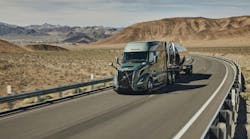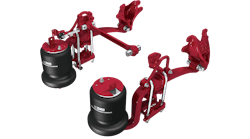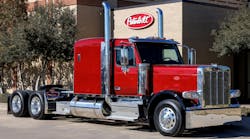“THE ECONOMY is back on track, and there is reason for optimism in the trucking business,” Andreas Renschler, member of the Board of Management of Daimler AG with responsibility for Daimler Trucks and Daimler Buses, said during a media briefing October 18 during the American Trucking Associations Annual Management Conference in Phoenix, Arizona.
In spite of continuing high unemployment, Renschler was generally optimistic about the future of the industry, both in the United States and abroad. “Business investment is gradually increasing,” he said. “By and large, we don't expect a ‘double-dip’, not here in the United States, and not globally. There is just going to be a slowdown of growth rates ahead. But I would rather have a slow recovery than another fast recession.”
By 2015, the world truck market is expected to grow by more than 50%, to roughly three-million units, Renschler added. The NAFTA market is “climbing out of a very deep hole,” and the heavy-duty market is still 62% below 2006 levels. However, investment growth and replacement of an aging fleet should result in more significant growth rates in 2011.
Elsewhere in the world, Daimler is seeing similar signs of recovery. He said that Europe is “getting better,” while Latin America, especially Brazil, remains “red hot.”
Asia trends
Renschler said that the company also is seeing a “significant upward trend” in Asia, where even the Japanese market is finally on its way up again. “We expect 7% growth this year alone,” he added, “And more trade means more transport.”
At Daimler Trucks, sales are up 34% (YTD September). “Third-quarter figures are not available [to the public] yet,” said Renschler, “but I can tell you that we expect an ongoing sales increase in comparison to the first half of the year. Concerning EbIT, we expect a result in the neighborhood of one billion Euros for 2010 as a whole, and all Daimler divisions are contributing to that success. Daimler Trucks North America [DTNA] is doing well again.”
Renschler said the company's Global Excellence strategy, launched six years ago, is the “primary reason for our strong position coming out of the recession,” noting that the first two pillars of the program, Management of Cycles and Operational Excellence, helped enable Daimler to improve effectiveness and efficiency and reduce costs in the process. The next two pillars of the strategy are now in the implementation phase: Growth and New Market Extension and Future Product Generations.
“Once you have great products, it makes sense to push them on a global scale,” he said. “As the world's largest commercial vehicle manufacturer, we have the best resources to do that. Our philosophy is: ‘As local as necessary, as global as possible.”
When it comes to a “world truck,” however, Renschler stressed there will be no “one-size-fits-all” truck for the global market, although the commonality rate “can be up to 70% right now. That means trucks for Asia, the United States or Europe could share a great amount of their parts in the future.” He added that commonality is “in the vital interest of our customers because every dollar of commonality savings can be invested in research and development.”
Renschler said the company last year “came close to selling every third of our trucks in the BRIC [Brazil, Russia, India and China market]” and so-called ‘Next 1’ markets. Among the examples he cited was the approval of a joint venture in China with Foton. “Every second truck over six tons is now sold in China,” he said.
North America
Martin Daum, president and chief executive officer of DTNA (manufacturer of Freightliner and Western Star trucks and Detroit Diesel engines), shared the North American company's forecasts for the year ahead, cautioning that it is “still very difficult to predict” exactly where truck sales will end up.
However, Daum said for NAFTA the original equipment manufacturer (OEM) is looking for 210,000 Class 6-8 trucks in 2010; 260,000 in 2011 and 330,000 by 2012.
“We are prepared to follow any upswing,” he said, noting that DTNA grew its market share from 31% to 34% during the recession and expects to maintain or even expand that further in 2011. “Managing in an upward cycle, takes as much skill as managing the downturn,” he said. “It's difficult today to add significant capacity.”
Daum added that DTNA survived the biggest North American market contraction in history. Over the course of the past year, the truck builder recaptured all of the volume lost with the shutdown of the Sterling brand, and the company has achieved a good worker balance between its manufacturing operations in the United States and Mexico.
Daum said DTNA's agenda for the year ahead will include:
-
Preparing for CO2 (greenhouse gas) regulations
-
Improving fuel efficiency
-
“Gaining speed” in vocational markets
On going green, Daum was bullish on the need to pursue alternative fuels, even though the return on investment is not there yet. “We have to get into the alternative power and fuels business,” he said, adding that government incentives are “the only way to go for alternative vehicles. We need this government support.”
The North American market offers opportunities for a variety of alternative power systems. Hybrid electric technology can increase fuel economy by 50% to 80%. Electric vehicles also have a place in the market.
Natural gas offers great opportunities for the future as an alternative fuel. Natural gas provides a 25% reduction in CO2 emissions without specialized emission control technology. In addition, the United States has abundant supplies of the fuel. However, advanced diesel fuels and technology will remain dominant for at least the next decade, Daum said.








